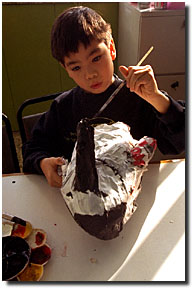
|
|
|
A young student works on his built-to-scale papier-mache penguin, an activity of the "Blue Ice: Focus on Antarctica" online curriculum. The student's class at Western Academy in Beijing has been studying the Blue Ice curriculum via the Internet, along with students in the United States and Europe. (Photograph by Adrian Bradshaw)
|
|

|
 am an explorer, an archaeologist, a scientist, a meteorologist, an analyst, a fighter pilot, a starship captain, a teacher, and a student when I use the Net," says Eric Ebner, a senior at Perham High School in rural Minnesota. His wonderment is genuine. As a "research participant" in the "Blue Ice: Focus on Antarctica" online curriculum, Ebner is one of 9,000 students, scattered around the globe, who spent the week of February 5, 1996, communicating with Bill Fraser, a scientist studying penguin ecosystems at Palmer Station, Antarctica. am an explorer, an archaeologist, a scientist, a meteorologist, an analyst, a fighter pilot, a starship captain, a teacher, and a student when I use the Net," says Eric Ebner, a senior at Perham High School in rural Minnesota. His wonderment is genuine. As a "research participant" in the "Blue Ice: Focus on Antarctica" online curriculum, Ebner is one of 9,000 students, scattered around the globe, who spent the week of February 5, 1996, communicating with Bill Fraser, a scientist studying penguin ecosystems at Palmer Station, Antarctica. During the 13-week Blue Ice curriculum, students from Beijing to Oslo received a stream of information from 13 scientists and explorers working on the frozen continent. On February 8, third-grade students in Mr. Wright's class at Columbus Avenue School in Valhalla, New York, prepared graphs from data supplied by Fraser that showed fluctuations in krill populations, expansion and contraction of the Antarctican ice shelf, and trends in penguin mortality. The third-graders were eager to interpret these phenomena. They observed that penguin populations decline when the ice shelf grows, while the krill population remains stable. They then hypothesized that the number of penguins declines because the larger ice shelf requires longer foraging trips, which exposes them to more danger. Students from other schools emailed Fraser their questions: "Why aren't there penguins at the North Pole?" "Have you ever been on an iceberg when it came apart?" Fraser, holed up that week in a blizzard, patiently answered them all. Students also had access to each other in a globe-spanning classroom forum. "First, we used the Internet to communicate with other Beijing schools," says John Liu, a student at Western Academy in Beijing. "But now we talk to students all over the world -- it's a lot cheaper than using a telephone."
|
|



